![と – Linking 'And', 'With', and Quotations in Japanese [JLPT N5]](http://hirakan.com/cdn/shop/articles/to-and-with-quotation.jpg?v=1763265110&width=1100)
と – Linking 'And', 'With', and Quotations in Japanese [JLPT N5]
Share
Quick Summary
Meaning: と links things like “A and B,” marks doing something with someone, and shows a quotation (“…,” someone says/thinks).
How to Use: Connect nouns (A と B), mark a partner (Person と V), or attach と to a quoted clause before verbs like 言います (iimasu, to say).
Example:
- 先生とラーメンを作ります。
- Sensei to raamen o tsukurimasu.
- I make ramen with my teacher.
Overview
The particle と has three beginner-friendly jobs.
First, it means “and” when you connect two (or more) nouns: A と B. This is an exact list—you mean A and B (and nothing else). If you want “A and B and more,” you’ll later meet や (ya, and such).
Second, と means “with” when you do something together with a person or animal: Person と V. Use と for partners. Do not use と for tools or methods; for those, Japanese uses で.
Third, と marks quotations: attach と to the end of what is said/thought, then add a verb like 言います (iimasu, to say), 思います (omoimasu, to think), or 聞きます (kikimasu, to ask/hear). The quoted part usually stays in plain (dictionary) form, even if the main sentence is polite.
Structure / Formation
Base formulas
- N1 と N2
- N と N と N
- Person と V
- Clause と 言います (iimasu, to say)
- Clause と 思います (omoimasu, to think)
- Clause と 聞きます (kikimasu, to ask/hear)
Connecting nouns: と = “and”
Use N1 と N2 to join nouns into a clear, complete list. You can chain more items: N と N と N. This と list is understood as “all of these, exactly.”
Example:
- 朝ごはんはパンとスイカです。
- Asagohan wa pan to suika desu.
- Breakfast is bread and watermelon.
Partner marker: と = “with (together with someone/animal)”
Use Person と V to show you do an action together with someone (or a pet, character, etc.). Remember: for tools or means (“with chopsticks,” “by bus”), Japanese uses で, not と.
Example:
- 猫と宿題をします。
- Neko to shukudai o shimasu.
- I do homework with my cat.
Quotation: Clause と + verb of saying/thinking
Put と after the quoted content, then add a verb like 言います (iimasu, to say), 思います (omoimasu, to think), or 聞きます (kikimasu, to ask/hear). The quoted clause typically uses the plain form.
| Plain form before と | Example pattern |
|---|---|
| V-る / V-た | V と 言います / V-た と 言います |
| i-adj | i-adj と 思います |
| N + だ | N だ と 思います |
| na-adj + だ | na-adj だ と 思います |
Example:
- ロボットは「眠い」と言います。
- Robotto wa “nemui” to iimasu.
- The robot says, “I’m sleepy.”
Example Sentences
- 昼ごはんはケーキとラーメンです。
- Hirugohan wa keeki to raamen desu.
- My lunch is cake and ramen.
- おばけとゲームをします。
- Obake to geemu o shimasu.
- I play games with a ghost.
- 猫は「人間だ」と言います。
- Neko wa “ningen da” to iimasu.
- The cat says, “I am human.”
- ブロッコリーはかわいいと思います。
- Burokkorii wa kawaii to omoimasu.
- I think broccoli is cute.
- 月に「チーズですか」と聞きます。
- Tsuki ni “chiizu desu ka” to kikimasu.
- I ask the moon, “Are you cheese?”
Quick Practice
(Answers and explanations are right under this section.)
Multiple-Choice
1. Choose the sentence that clearly means “I eat bread and eggs (only).”
- A. 私はパンとたまごを食べます。(Watashi wa pan to tamago o tabemasu.)
- B. 私はパンやたまごを食べます。(Watashi wa pan ya tamago o tabemasu.)
- C. 私はパンでも食べます。(Watashi wa pan demo tabemasu.)
- D. 私はパンとたまごです。(Watashi wa pan to tamago desu.)
2. Choose the correct sentence: “I watch a movie with my grandma.”
- A. 私はおばあさんと映画を見ます。(Watashi wa obaasan to eiga o mimasu.)
- B. 私はおばあさんで映画を見ます。(Watashi wa obaasan de eiga o mimasu.)
- C. 私はおばあさんを映画と見ます。(Watashi wa obaasan o eiga to mimasu.)
- D. 私はおばあさんに映画を見ます。(Watashi wa obaasan ni eiga o mimasu.)
3. Choose the correct sentence using と with 思います: “I think sushi is delicious.”
- A. 寿司はおいしいと思います。(Sushi wa oishii to omoimasu.)
- B. 寿司はおいしいですと思います。(Sushi wa oishii desu to omoimasu.)
- C. 寿司はおいしいとです。(Sushi wa oishii to desu.)
- D. 寿司はおいしくと思います。(Sushi wa oishiku to omoimasu.)
4. Choose the correct sentence that means “I ask the teacher, ‘Is it homework?’”
- A. 先生に「宿題ですか」と聞きます。(Sensei ni “shukudai desu ka” to kikimasu.)
- B. 先生と「宿題ですか」に聞きます。(Sensei to “shukudai desu ka” ni kikimasu.)
- C. 先生は「宿題ですか」と聞きます。(Sensei wa “shukudai desu ka” to kikimasu.)
- D. 先生に「宿題ですか」を聞きます。(Sensei ni “shukudai desu ka” o kikimasu.)
5. Choose the sentence that uses と to make a complete list of three items: apples, bananas, and milk.
- A. りんごとバナナと牛乳を買いました。(Ringo to banana to gyuunyuu o kaimashita.)
- B. りんごやバナナや牛乳を買いました。(Ringo ya banana ya gyuunyuu o kaimashita.)
- C. りんごとバナナや牛乳を買いました。(Ringo to banana ya gyuunyuu o kaimashita.)
- D. りんご、バナナ、牛乳を買いました。(Ringo, banana, gyuunyuu o kaimashita.)
Spot-the-Error
6. One sentence has an error with と. Which one?
- A. 母とパンを作ります。(Haha to pan o tsukurimasu.)
- B. フォークとサラダを食べます。(Fooku to sarada o tabemasu.)
- C. 弟と歌います。(Otouto to utaimasu.)
7. One sentence has an error with quotation と. Which one?
- A. 王さまは「眠い」と言います。(Ousama wa “nemui” to iimasu.)
- B. 私は「明日行く」思います。(Watashi wa “ashita iku” omoimasu.)
- C. ロボットは「人間だ」と思います。(Robotto wa “ningen da” to omoimasu.)
Translation
8. Translate into Japanese using と: “Dinner is octopus and pizza.”
9. Translate into Japanese using と: “I study with my alien friend.”
10. Translate into Japanese using と: “Grandpa says, ‘I am a gamer.’”
Answers and Explanations
- A. 私はパンとたまごを食べます。(Watashi wa pan to tamago o tabemasu.) — Use と to list exactly two nouns as a complete set.
- A. 私はおばあさんと映画を見ます。(Watashi wa obaasan to eiga o mimasu.) — と marks the partner you do the action with.
- A. 寿司はおいしいと思います。(Sushi wa oishii to omoimasu.) — The clause before と思います stays in plain form.
- A. 先生に「宿題ですか」と聞きます。(Sensei ni “shukudai desu ka” to kikimasu.) — Use に for the person you ask and と before 聞きます.
- A. りんごとバナナと牛乳を買いました。(Ringo to banana to gyuunyuu o kaimashita.) — Repeat と to show a complete three-item list.
- B. フォークとサラダを食べます。(Fooku to sarada o tabemasu.) — Tools take で, so it should be フォークでサラダを食べます。(Fooku de sarada o tabemasu.)
- B. 私は「明日行く」思います。(Watashi wa “ashita iku” omoimasu.) — You must add と before 思います.
- 晩ごはんはたことピザです。(Bangohan wa tako to piza desu.) — Use と to join two foods in a complete list.
- 宇宙人の友だちと勉強します。(Uchuujin no tomodachi to benkyou shimasu.) — と marks “with” (your study partner).
- おじいさんは「ゲーマーだ」と言います。(Ojiisan wa “geemaa da” to iimasu.) — Put と after the quote before 言います, and use だ with a noun inside the quote.
Related Posts
-
![~から~まで – Saying “From A to B” in Japanese [JLPT N5]](//hirakan.com/cdn/shop/articles/from-AtoB.jpg?v=1765093560&width=170)
~から~まで – Saying “From A to B” in Japanese [JLPT N5]
Quick Summary Meaning: ~から~まで shows the starting point and ending point of something: “from A to B.” It is ofte...
-
![まで – Expressing “Until” and “Up To” in Japanese [JLPT N5]](//hirakan.com/cdn/shop/articles/until-up-to.jpg?v=1765093405&width=170)
まで – Expressing “Until” and “Up To” in Japanese [JLPT N5]
Quick Summary Meaning: まで (made) means “until” or “up to” and shows a limit of time, place, number, or even act...
-
![から – Expressing “Because” and “From/Since” in Japanese [JLPT N5]](//hirakan.com/cdn/shop/articles/because-from_since.jpg?v=1765093285&width=170)
から – Expressing “Because” and “From/Since” in Japanese [JLPT N5]
Quick Summary Meaning: から shows a reason (“because”) or a starting point (“from / since”). How to Use: Put...
-
![や – Listing Examples with “And, Among Others” in Japanese [JLPT N5]](//hirakan.com/cdn/shop/articles/and.jpg?v=1765093138&width=170)
や – Listing Examples with “And, Among Others” in Japanese [JLPT N5]
Quick Summary Meaning: や connects two or more nouns and means “and” or “among other things.” It shows that your lis...
-
![か – Forming Questions and Saying “Or” in Japanese [JLPT N5]](//hirakan.com/cdn/shop/articles/ka-questions.jpg?v=1763787134&width=170)
か – Forming Questions and Saying “Or” in Japanese [JLPT N5]
Quick Summary Meaning: The particle か turns a sentence into a question, or can mean “or” when choosing between thin...
-
![も – Saying “Also” and “Too” in Japanese [JLPT N5]](//hirakan.com/cdn/shop/articles/mo-also-too_99f908e6-78d0-4f82-8319-391ef42764bc.jpg?v=1763787251&width=170)
も – Saying “Also” and “Too” in Japanese [JLPT N5]
Quick Summary Meaning: The particle も means “also,” “too,” or “even.” It shows that something is the same as someth...
-
![で – Marking Where and How an Action Happens in Japanese [JLPT N5]](//hirakan.com/cdn/shop/articles/de-where-how-action-happens.jpg?v=1763264973&width=170)
で – Marking Where and How an Action Happens in Japanese [JLPT N5]
Quick Summary Meaning: で marks the location where an action happens or the means/tool/method used to do something...
-
![へ – Marking Direction ‘Toward’ in Japanese [JLPT N5]](//hirakan.com/cdn/shop/articles/he-marking-direction.jpg?v=1762667986&width=170)
へ – Marking Direction ‘Toward’ in Japanese [JLPT N5]
Quick Summary Meaning: The particle へ marks direction or “toward” a place or person. It points where something is hea...
-
![に – Marking Time, Destinations, and Recipients in Japanese [JLPT N5]](//hirakan.com/cdn/shop/articles/ni-marking-destination.jpg?v=1762667846&width=170)
に – Marking Time, Destinations, and Recipients in Japanese [JLPT N5]
Quick Summary Meaning: The particle に marks a point in time (at/on), a destination you reach (to/into), or a target/r...
-
![の – Possession and Noun Linking in Japanese [JLPT N5]](//hirakan.com/cdn/shop/articles/no-possession-and-noun-linking.jpg?v=1761961297&width=170)
の – Possession and Noun Linking in Japanese [JLPT N5]
Quick Summary Meaning: Links two nouns to show possession, belonging, or description. Often reads as “’s” or “of....
-
![を – Marking the Direct Object in Japanese [JLPT N5]](//hirakan.com/cdn/shop/articles/o-direct-object.jpg?v=1761960990&width=170)
を – Marking the Direct Object in Japanese [JLPT N5]
Quick Summary Meaning: を marks the direct object — the thing that receives the action of a verb. It’s pronounced ...
-
![が – Marking the Subject ('Who/What') in Japanese [JLPT N5]](//hirakan.com/cdn/shop/articles/ga-subject-marker_60f30f70-6ca5-47ee-9a00-3646195d7d3c.jpg?v=1761386355&width=170)
が – Marking the Subject ('Who/What') in Japanese [JLPT N5]
Quick Summary Meaning: The particle が marks the subject of a sentence and highlights new or focused information (an...
-
![は (wa) – Topic Marker and Contrast in Japanese [JLPT N5]](//hirakan.com/cdn/shop/articles/wa-topic-marker.jpg?v=1761385996&width=170)
は (wa) – Topic Marker and Contrast in Japanese [JLPT N5]
Quick Summary Meaning: Marks the topic of the sentence — what you’re talking about. Often feels like “as for...” in E...
-
![じゃない・ではありません – Expressing 'Is/Was Not' in Japanese [JLPT N5]](//hirakan.com/cdn/shop/articles/janai-dehaarimasen_2594963b-531e-4f4d-a9b0-361010e0a720.jpg?v=1760865884&width=170)
じゃない・ではありません – Expressing 'Is/Was Not' in Japanese [JLPT N5]
Quick Summary Meaning: The negative of the copula “to be.” Say “is not” or “was not” with nouns and na-adjectives. Ho...
-
![だ・です/だった・でした – Saying ‘to be’ in Japanese [JLPT N5]](//hirakan.com/cdn/shop/articles/da-desu-datta-deshita_58bbc732-53fd-48da-83c7-4e477e7cc0b2.jpg?v=1760864506&width=170)
だ・です/だった・でした – Saying ‘to be’ in Japanese [JLPT N5]
Quick Summary Meaning: The Japanese copula — the basic “to be.” It links a topic to a noun or a na-adjective to state...
-

Common Japanese Onomatopoeia: Essential Words You’ll Hear Everywhere
If you spend any time in Japan, you’ll hear onomatopoeia everywhere: on TV, in everyday conversations, in manga, and ...
-

How to Say “To Increase” and “To Decrease” in Japanese: With Examples
You've noticed there are multiple ways to say “to increase” or "to decrease" in Japanese. Between transitive and intr...
-

How to Say "Police Officer" in Japanese: Common Terms and Slang
There are several ways to say "police officer" in Japanese, and each one has a different level of formality and usage...
-
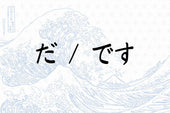
Understanding だ (da) and です (desu) in Japanese: Meaning and Usage
When learning Japanese, one of the first things you’ll come across is だ (da) and です (desu). These words don’t have a ...
-
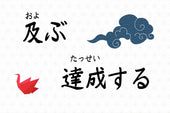
Difference Between 及ぶ (およぶ) and 達成する (たっせいする)
Both 及ぶ and 達成する can relate to "reaching" or "achieving" something, but they have distinct nuances and usage contexts...
-

JLPT N5 Study Guide: A Beginner's Roadmap to Acing the Test
If you’ve just started learning Japanese and are aiming to ace the JLPT N5, you’ll need a solid study guide to help y...
-

Beginner's Guide to Japanese Particles: Learn the Basics
TL;DR: Japanese particles are crucial for structuring sentences, acting like conjunctions or prepositions in English...
-

JLPT N5 Vocabulary List - All 748 Words You Need to Know
Vocabulary is the foundation of any language, and Japanese is no exception. The more you know, the better. Over time ...
-

JLPT N4 Kanij List - All 176 Characters You Need To Know
After mastering the JLPT N5 kanji, you're ready to take your Japanese kanji game to the next level. JLPT N4. Let's go...
-
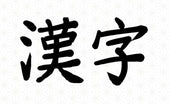
Kanji For Kanji - 漢字
Inception time. Which kanji compose the kanji of "kanji"? The kanji for "kanji" is actually pretty straightforward. I...
-

How to Memorize Katakana Easily: 9 Tips for Beginners
For those diving into Japanese, mastering hiragana and katakana is the first significant challenge. While hiragana o...
-

Complete Hiragana and Katakana Chart With All 112 Characters
The very first step for everybody who wants to learn Japanese is to study the hiragana and katakana chart (before lea...
-
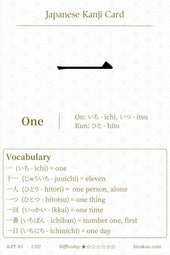
JLPT N5 Kanji: Kanji For One 一 (ichi)
Probably one the most simple kanji to remember, the kanji for 'one' is simply written '一'. Let's see its readings and...
-
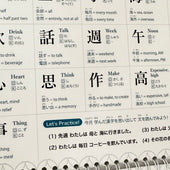
How Long Does It Take to Learn Kanji? A Beginner's Guide
Ask any Japanese student what's the scariest part of learning the language, and they'll say kanji. And they're righ...
-

Is it Necessary to Learn Kanji? The Last Answer You'll Ever Need
Many beginners in Japanese wonder whether they should really learn kanji. I know this, because I also wondered when s...
-

How Long Does it Take to Learn Hiragana and Katakana?
As a beginner in Japanese, your first step is diving into the alphabets of Hiragana and Katakana. These are the build...
-

13 Best YouTube Channels to Learn Japanese, From Beginner to Intermediate
YouTube can be an incredible resource for learning Japanese. And best of all, it's free. So we've compiled a list of ...
-
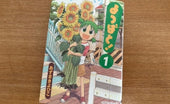
Top 10 Manga for Japanese Language Learners: From Beginners to Intermediates!
If you're learning Japanese, chances are you're interested in manga. So instead of reading texts about Tanaka-san s...
-
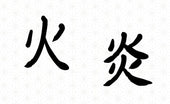
Kanji for 'Fire' in Japanese: 火 or 炎?
Welcome to our enlightening exploration of Japanese kanji! Today, we're igniting our understanding of a primal force ...
-

The Complete Guide to Country Names in Japanese: Say and Pronounce Them Right!
Whether you're planning a trip, learning Japanese, or just curious about how different countries are represented in a...
-
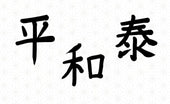
Kanji for Peace: 平, 和, 泰 - The Symbols of Harmony
You might be wondering what are the Japanese symbols for 'Peace'. In this article, we're diving deep into this univer...
-
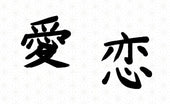
Kanji for 'Love': How and When to Use 愛 and 恋
Welcome to our journey into the world of Japanese kanji! Today, we're delving into one of the most heartwarming and p...
-
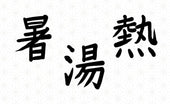
Kanji for 'Hot' in Japanese: 暑, 湯, and 熱 - A Comprehensive Guide
Welcome to our journey into the world of Japanese kanji! Today, we're going to delve into an exciting and essential c...
-
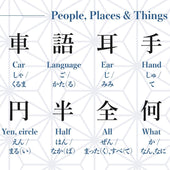
JLPT N5 Kanji List - All 112 Characters You Need To Know
Below we've listed all 112 JLPT N5 level kanji along with their English meaning, readings, and two accompanying vocab...

![~から~まで – Saying “From A to B” in Japanese [JLPT N5]](http://hirakan.com/cdn/shop/articles/from-AtoB.jpg?v=1765093560&width=170)
![まで – Expressing “Until” and “Up To” in Japanese [JLPT N5]](http://hirakan.com/cdn/shop/articles/until-up-to.jpg?v=1765093405&width=170)
![から – Expressing “Because” and “From/Since” in Japanese [JLPT N5]](http://hirakan.com/cdn/shop/articles/because-from_since.jpg?v=1765093285&width=170)
![や – Listing Examples with “And, Among Others” in Japanese [JLPT N5]](http://hirakan.com/cdn/shop/articles/and.jpg?v=1765093138&width=170)
![か – Forming Questions and Saying “Or” in Japanese [JLPT N5]](http://hirakan.com/cdn/shop/articles/ka-questions.jpg?v=1763787134&width=170)
![も – Saying “Also” and “Too” in Japanese [JLPT N5]](http://hirakan.com/cdn/shop/articles/mo-also-too_99f908e6-78d0-4f82-8319-391ef42764bc.jpg?v=1763787251&width=170)
![で – Marking Where and How an Action Happens in Japanese [JLPT N5]](http://hirakan.com/cdn/shop/articles/de-where-how-action-happens.jpg?v=1763264973&width=170)
![へ – Marking Direction ‘Toward’ in Japanese [JLPT N5]](http://hirakan.com/cdn/shop/articles/he-marking-direction.jpg?v=1762667986&width=170)
![に – Marking Time, Destinations, and Recipients in Japanese [JLPT N5]](http://hirakan.com/cdn/shop/articles/ni-marking-destination.jpg?v=1762667846&width=170)
![の – Possession and Noun Linking in Japanese [JLPT N5]](http://hirakan.com/cdn/shop/articles/no-possession-and-noun-linking.jpg?v=1761961297&width=170)
![を – Marking the Direct Object in Japanese [JLPT N5]](http://hirakan.com/cdn/shop/articles/o-direct-object.jpg?v=1761960990&width=170)
![が – Marking the Subject ('Who/What') in Japanese [JLPT N5]](http://hirakan.com/cdn/shop/articles/ga-subject-marker_60f30f70-6ca5-47ee-9a00-3646195d7d3c.jpg?v=1761386355&width=170)
![は (wa) – Topic Marker and Contrast in Japanese [JLPT N5]](http://hirakan.com/cdn/shop/articles/wa-topic-marker.jpg?v=1761385996&width=170)
![じゃない・ではありません – Expressing 'Is/Was Not' in Japanese [JLPT N5]](http://hirakan.com/cdn/shop/articles/janai-dehaarimasen_2594963b-531e-4f4d-a9b0-361010e0a720.jpg?v=1760865884&width=170)
![だ・です/だった・でした – Saying ‘to be’ in Japanese [JLPT N5]](http://hirakan.com/cdn/shop/articles/da-desu-datta-deshita_58bbc732-53fd-48da-83c7-4e477e7cc0b2.jpg?v=1760864506&width=170)























